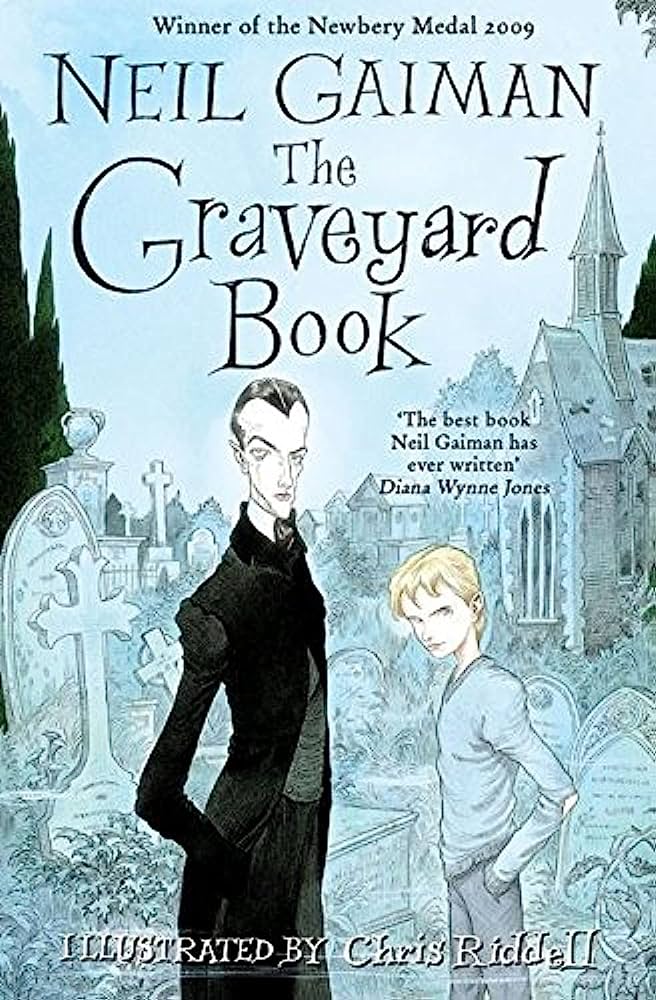This is a spoiler-free review.
Today we are jumping into a curious story about a boy who is raised by ghosts: The Graveyard Book by Neil Gaiman. Get ready for a beautifully written journey through the unlikeliest of places – a cemetery.
What is the Graveyard Book, you ask? Well, I have an answer: it’s Blurb time!
Here’s the blurb that booksellers use to describe this book:
“IT TAKES A GRAVEYARD TO RAISE A CHILD.
Nobody Owens, known as Bod, is a normal boy. He would be completely normal if he didn’t live in a graveyard, being raised by ghosts, with a guardian who belongs to neither the world of the living nor the dead. There are adventures in the graveyard for a boy—an ancient Indigo Man, a gateway to the abandoned city of ghouls, the strange and terrible Sleer. But if Bod leaves the graveyard, he will be in danger from the man Jack—who has already killed Bod’s family.”
Neil Gaiman is a prolific and accomplished writer with many books to his name. He is renowned as an excellent storyteller and inventor of oddities. Because of this, quite a bit of his work has been turned into Tv series or movies. But none of that tells us for sure if The Graveyard Book is worth reading or not.
Let’s take a look at the themes and see what they have to say.
Themes
The story of Nobody Owens is a story about growing up, and the various themes of the book relate to that premise in some way. There are many lessons for a boy or girl to learn as they grow up, and they are lessons that stick with us for our entire lives. One of the those lessons is the truth that what is good is not always easy. From a very young age, Bod feels that disdain for structure we all feel sometimes when he meets Miss Lupescu. She is a tutor of sorts who forces him to study as well as eat yucky meals (much more boring than the bananas and packaged convenience store food he’s been eating most of his life). But structure is important, and so is paying attention to what your teacher is telling you. It’s not always easy to listen, but it is important and might just save your life. Another difficult choice that Bod’s guardian, Silas, has to make for the boy is that he cannot go to school with other children. It is a difficult choice for Silas, and a difficult pill to swallow for Bod.
That brings me to another theme covered in the book: trust. Bod learns that although it may seem cruel or unfair in the moment, the choices that his adopted parents and guardian make are for the best. They love him and want the best for him, and he learns to trust them, even when he doesn’t have all the answers.
So what did I like about the book:
Things I Liked
The beginning is so good. If you read the first page of this book, you won’t be able to put it down. From the beginning, we understand that this book is going to bring up life and death. I think the danger of a book like this could be that it becomes extremely heavy or sad; the opposite of that is true too. It could treat death as funny or light. I think Gaiman found the perfect approach.
I like how ghosts are not evil in this story. You know, often we think of ghosts as spooky or bad, and that comes from centuries of superstition as well as a legitimate association between death and evil. Modern depictions of ghosts and even other dead or undead creatures haven’t helped. But Gaiman takes this unique approach where ghosts are just people who are no longer living. They retain their personality and their mannerisms after death. They’re more like Casper the Friendly Ghost than anything else.
Though it’s a book about death, and most of the characters are dead, the Graveyard Book is overtly positive about the brilliance of being alive. Bod is alive, and the people of the graveyard want him to live a full and happy life, even though that means he might leave them and the graveyard behind.
One more thing I’ll say is I loved the mystery of Bod’s guardian, Silas. He is a stoic and meek individual that you will love from the beginning. I won’t say much more, but I enjoyed trying to discover more about him as Gaiman dropped his subtle hints.
Ok, so what about the things you should be aware of before recommending this to the kid or teen in your life:
Things to Know
The most obvious potential issue with this book is it’s emphasis on death. Most of the characters are ghosts, and I understand that some families don’t like the idea of ghosts or want to support any sort of macabre celebrations such as Halloween. This book has nothing to do with Halloween, but regardless, it may not be for your kid. It’s not a horror book, it’s not a scary book, and it doesn’t have zombies or demons or any of that stuff in it. There are ghouls, which are really just this world’s version of little goblins. And there is a witch, but her title as witch is little more than a footnote about her character. If any of those facts would be a determining factor for you, I want you to be aware.
Otherwise, there are no curse words that I could find, and there’s nothing content related that I think is inappropriate for 10-12 year olds.
If you’re not sure, or if you’re willing to give this book a try, you can listen to the author read the first two chapters on YouTube; I’ll link the first video in the description of this review. That way you can get a taste of what this book is like, and how Gaiman approaches the subject of the deceased.
So how do I rate the Graveyard book? Remember our rating scale goes from red, orange, yellow, green, to Cyan. Red is the worst rating we can give, and Cyan is the very best.
Rating
I think The Graveyard Book is a Green book on our scale. It is extremely well written, it has an excellent plot with well developed characters, and it has very little in the way of questionable content. It forces the reader to ask a very important question: “Who’s the real monster of the story?” The only reason it isn’t a CYAN book is because of its emphasis on ghosts and death. It’s not for all kids, and it’s not for all families. The topics of death and ghosts have various associations that for some make them themes to be avoided, and that’s understandable.


Leave a comment